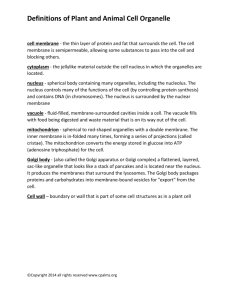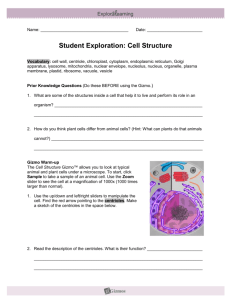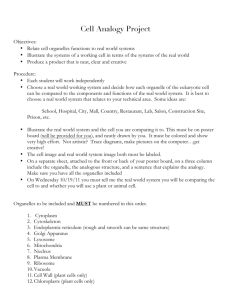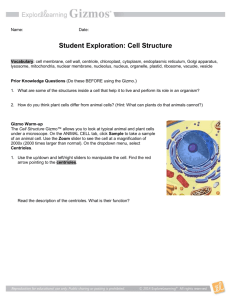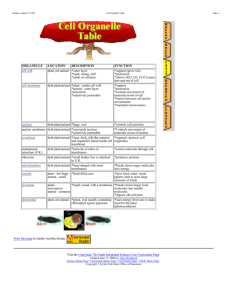Cell Structure Vocabulary & Activities Worksheet
advertisement
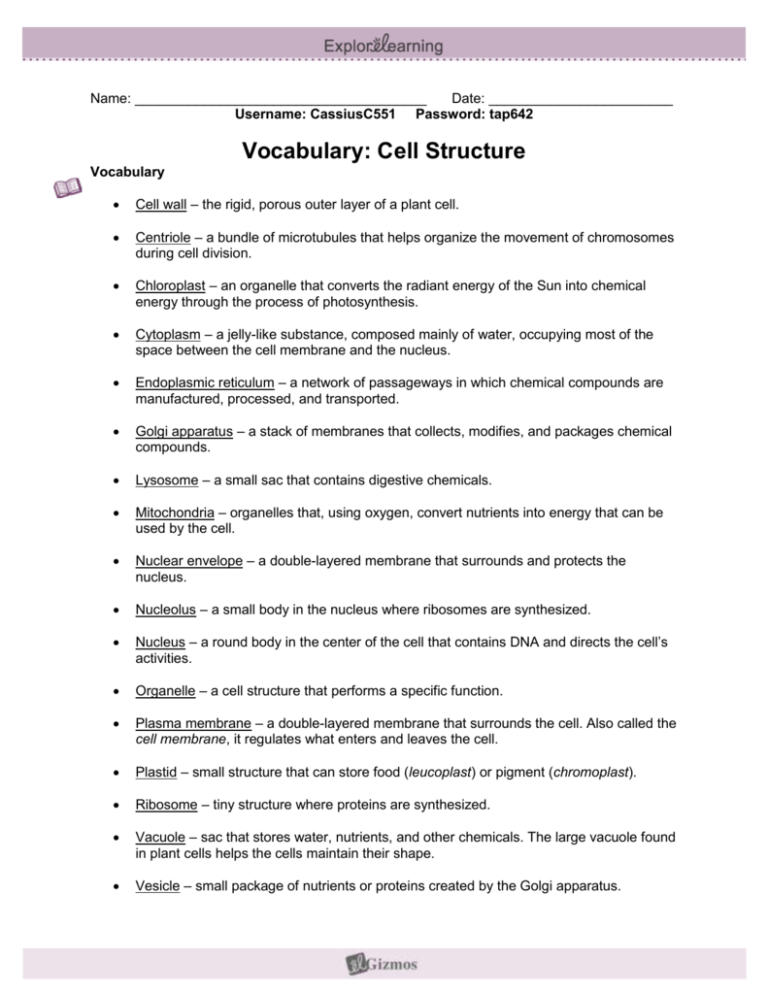
Name: ______________________________________ Date: ________________________ Username: CassiusC551 Password: tap642 Vocabulary: Cell Structure Vocabulary Cell wall – the rigid, porous outer layer of a plant cell. Centriole – a bundle of microtubules that helps organize the movement of chromosomes during cell division. Chloroplast – an organelle that converts the radiant energy of the Sun into chemical energy through the process of photosynthesis. Cytoplasm – a jelly-like substance, composed mainly of water, occupying most of the space between the cell membrane and the nucleus. Endoplasmic reticulum – a network of passageways in which chemical compounds are manufactured, processed, and transported. Golgi apparatus – a stack of membranes that collects, modifies, and packages chemical compounds. Lysosome – a small sac that contains digestive chemicals. Mitochondria – organelles that, using oxygen, convert nutrients into energy that can be used by the cell. Nuclear envelope – a double-layered membrane that surrounds and protects the nucleus. Nucleolus – a small body in the nucleus where ribosomes are synthesized. Nucleus – a round body in the center of the cell that contains DNA and directs the cell’s activities. Organelle – a cell structure that performs a specific function. Plasma membrane – a double-layered membrane that surrounds the cell. Also called the cell membrane, it regulates what enters and leaves the cell. Plastid – small structure that can store food (leucoplast) or pigment (chromoplast). Ribosome – tiny structure where proteins are synthesized. Vacuole – sac that stores water, nutrients, and other chemicals. The large vacuole found in plant cells helps the cells maintain their shape. Vesicle – small package of nutrients or proteins created by the Golgi apparatus. Student Exploration: Cell Structure Vocabulary: cell wall, centriole, chloroplast, cytoplasm, endoplasmic reticulum, Golgi apparatus, lysosome, mitochondria, nuclear envelope, nucleolus, nucleus, organelle, plasma membrane, plastid, ribosome, vacuole, vesicle Prior Knowledge Questions (Do these BEFORE using the Gizmo.) 1. What are some of the structures inside a cell that help it to live and perform its role in an organism? ________________________________________________________________ _________________________________________________________________________ 2. How do you think plant cells differ from animal cells? (Hint: What can plants do that animals cannot?) __________________________________________________________________ _________________________________________________________________________ Gizmo Warm-up The Cell Structure Gizmo™ allows you to look at typical animal and plant cells under a microscope. To start, click Sample to take a sample of an animal cell. Use the Zoom slider to see the cell at a magnification of 1000x (1000 times larger than normal). 1. Use the up/down and left/right sliders to manipulate the cell. Find the red arrow pointing to the centrioles. Make a sketch of the centrioles in the space below. 2. Read the description of the centrioles. What is their function? ________________________ _________________________________________________________________________ _________________________________________________________________________ Get the Gizmo ready: Activity A: Animal cells Check that an Animal cell is mounted on the microscope. Set the Zoom to 500x. Question: Organelles are specialized structures that perform various functions in the cell. What are the functions of the organelles in an animal cell? 1. Label: Locate each organelle in the animal cell. Label the organelles in the diagram below. 2. Match: Read about each organelle. Then match each organelle to its function/description. ____ Cytoplasm A. Structure that organizes motion of chromosomes. ____ Lysosome B. Stack of membranes that packages chemicals. ____ Mitochondria C. Membrane that protects the nucleus. ____ Centriole D. Membrane that surrounds and protects the cell. ____ Endoplasmic reticulum E. Sac filled with digestive chemicals. ____ Vacuole F. Structures that converts nutrients to energy. ____ Plasma membrane G. Passageways where chemicals are made. ____ Nucleus H. Jelly-like substance within the plasma membrane. ____ Ribosome I. ____ Nuclear envelope J. Structure that contains DNA and directs the cell. ____ Golgi apparatus K. Package created by the Golgi apparatus. ____ Vesicle L. Small structure that synthesizes proteins. ____ Nucleolus M. Sac that stores water, nutrients, or waste products. Structure that manufactures ribosomes. Activity B: Plant cells Get the Gizmo ready: Select View plant cell, and click Sample. Set the Zoom to 500x. Question: What functions do the organelles in a plant cell perform? 1. Label: Locate each organelle in the plant cell. Label the organelles in the diagram below. 2. Compare: What structures are present in an animal cell, but not in a plant cell? __________ _________________________________________________________________________ What structures are present in a plant cell, but not in an animal cell? __________________ _________________________________________________________________________ 3. Fill in: Name the organelle or organelles that perform each of the following functions. A. _____________________ convert sunlight to chemical energy. B. The _____________________ and the _____________________ help to support the plant cell and help it to maintain its shape. C. _____________________ store food or pigments. D. The _____________________ converts food into energy. It is found in both plant cells and animal cells.


